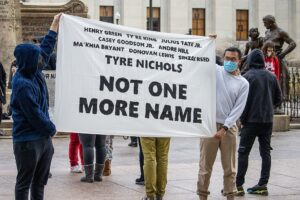This Week SCOTUS Will Take Up One of the Most Important Civil Rights Cases of the Last Decade
Many fear Texas case could gut the landmark Fair Housing Act. Shutterstock
Shutterstock
By Nikole Hannah-Jones, ProPublicaThis piece originally ran on ProPublica.
If you’ve never heard of Texas Department of Housing and Community Affairs v. The Inclusive Communities Project, you have company. The issue of housing segregation has never captivated the nation’s attention like affirmative action or voting rights.
But just two days after the Martin Luther King Jr. holiday, the court will hear arguments in the Texas case that many fear could gut the Fair Housing Act, the landmark 1968 law that was passed just days after King’s assassination.
“This case has as broad of a reach as anything the court has decided in the last 10 years,” said Myron Orfield, director of the Institute on Metropolitan Opportunity at the University of Minnesota Law School, because housing segregation is the foundation of racial inequality in the United States.
The case concerns whether the Fair Housing Act, which sought to end the longstanding segregation of America’s neighborhoods, should be read to only bar intentional discrimination. For four decades, federal courts have held that the law should be interpreted more broadly, ruling again and again that if the policies of governmental agencies, banks or private real estate companies unjustifiably perpetuate segregation, regardless of their intent, they could be found in violation of the Fair Housing Act.
All 11 of the federal circuit courts that have considered the question have seen it that way. As well, the U.S. Department of Housing and Urban Development, the agency charged with administering the act, issued a regulation enshrining the principle in 2013.
The nation’s highest court does not typically intervene in cases unless there’s been disagreement in the lower courts. But this court has been determined to have its say on the housing issue and the legal theory that has come to be known as “disparate impact.” The Texas case marks the third effort in as many years by the current justices to consider the intent and reach of the housing act. The other two cases were withdrawn or settled in deals reached before oral arguments, as fair housing advocates feared they would lose before the Roberts Court.
“It is unusual for the Court to agree to hear a case when the law is clearly settled. It’s even more unusual to agree to hear the issue three years in a row,” said Ian Haney López, a University of California, Berkeley law professor.
The Texas case involves a nonprofit organization that works to promote integrated communities and the Texas state housing authority. The nonprofit, Inclusive Communities, showed that nearly all the affordable housing tax credits approved by the Texas housing agency had been assigned to Dallas’ black neighborhoods and almost none of it to white neighborhoods. A federal judge did not find intentional discrimination on the part of Texas officials, but held that the outcome unacceptably increased housing segregation and that the housing agency could have taken steps to ensure that affordable housing units were allotted more equally.
Texas appealed the ruling, raising the stakes when it decided to challenge whether the Fair Housing Act allowed such “disparate impact” rulings at all.
For many, the Supreme Court’s persistence signals a determination to install intentional discrimination alone as the standard for such cases. The Roberts Court is considered by a host of scholars and others to be the most conservative since the 1930s, and so such an outcome would be consistent with its more narrow interpretations of laws governing voting rights and school segregation.
“Those who care about eradicating housing discrimination have to be very concerned about the Supreme Court taking this case,” said Erwin Chemerinsky, dean of the University of California School of Law, where he is a constitutional scholar.
Elizabeth Julian, president of the Inclusive Communities Project and the former Assistant Secretary of Fair Housing and Equal Opportunity at HUD, is among those who are worried.
“Reversing essentially four decades of case law would send a message that is very concerning,” Julian said.
A few generations ago, most housing discrimination was overt. Banks openly refused to lend to black homebuyers. Public housing officials used to announce that certain developments were for white residents, others for Latinos. But the nature of housing segregation has evolved over the years, and the fight against it has had to change as well. Today, banks may well charge higher loan rates in certain communities, but they can also insist it has nothing to do with those neighborhoods being black or Latino. Local planning boards can concede that most affordable housing efforts have been placed in black neighborhoods, but maintain that it was not by malicious design.
The theory of disparate impact, then, has often been the only tool to address ongoing housing discrimination. Landlords or lenders who implement policies or practices that disproportionately impact racial minorities can be found in violation of civil rights law if they cannot justify those practices – even if no one can show they acted out of racial animus.
The U.S. Department of Justice has used disparate impact to win record settlements from banks that charged higher rates to black and Latino borrowers with similar credit histories as white borrowers, but could not justify the practice.
A fair housing group used disparate impact to topple a “blood relative” ordinance passed by nearly all-white St. Bernard’s Parish in the wake of Hurricane Katrina. The ordinance barred homeowners from renting to anyone who was not kin. Civil rights lawyers were convinced officials passed this law to keep out black renters, but could not prove racist motivations. But when St. Bernard’s Parish could not come up with a plausible justification for the ordinance, a court struck it down.
This tool, for the first time, is in real jeopardy.
The Supreme Court has been weakening many civil rights protections for decades. The Rehnquist Court, for instance, was known for getting the courts out of the business of addressing racial inequities. But the Roberts Court has gone a critical step further, severely curbing efforts undertaken by Congress and the executive branch to address our nation’s long history of discrimination.
In 2007, the Roberts Court came down against two school districts that were trying to maintain gains in integration. In 2009, the court ended the attempts of New Haven, Conn., officials to ensure that the city’s promotion practices were fair after no black firemen passed a promotion exam, saying the efforts discriminated against white firefighters. In 2013, it held that a key provision of the Voting Rights Act intended to address the disenfranchisement of black voters had expired. And last year, it upheld Michigan voter-approved ban on affirmative action.
“The Supreme Court is newly aggressive in the area of race,” said Haney López. It is targeting efforts by other branches of society to remedy segregation and is striking them down.”
Strikingly, if it ultimately rules against Inclusive Communities, in under a decade the Roberts Court will have limited pivotal protections in each of the three landmark civil rights laws passed in the 1960s: the 1964 Civil Rights Act, the 1965 Voting Rights Act and the 1968 Fair Housing Act.
The Court’s aggressive tack has been welcomed by conservative groups, who believe the 14th Amendment of the Constitution, intended to ensure former slaves equality under the law, requires strict legal colorblindness.
The Pacific Legal Foundation, an advocacy organization that promotes individual rights, has long looked forward to a showdown over the Fair Housing Act. It filed an amicus brief in support of the Texas housing agency..
Ralph Kasarda, a lawyer at the Pacific Legal Foundation, said that disparate impact puts an unfair burden on landlords, lenders and local governments.
He gives this example. A landlord requires a certain credit score for renters in order to ensure that they will pay their rent. For a host of societal reasons, African Americans and Latinos tend to have lower credit scores. The landlord could find himself defending against a fair housing suit for a race-neutral policy.
“The problem that I have is imposing liability on someone for doing something without any intent to harm someone,” Kasarda said.
Of course, even under the legal theory of disparate impact, legitimate business practices that can be justified do not violate the law even if they lead to different results among different racial groups.
But the Pacific Legal Foundation’s chief gripe is race consciousness itself.
In order for Texas housing officials to ensure they were allotting subsidized housing in a racially balanced way, they would have had to take into account the racial makeup of the communities where the housing was to go. Kasarda and others argue that race-conscious policies designed to help racial minorities are no better than those designed to harm them.
“You have the case where a government or organization might resort to race-based decisions to avoid disparate impact,” he said. “The Pacific Legal Foundation believes that is unconstitutional.”
Julian, of Inclusive Communities, doesn’t buy the conservative argument. The Fair Housing Act was designed to address the effects of racial segregation, she said.
“It doesn’t require getting into the hearts and minds of people and motives of individuals because at the end of the day the motives don’t matter. It’s the perpetuation of segregation that is the harm,” Julian said.
She offered an analogy: Say a driver is texting and hits someone with her car and puts them in the hospital.
“The fact that you did not mean to is beside the point,” Julian said. “No, you didn’t mean to hit them, but you are going to be held accountable because you engaged in behavior that you knew could cause harm, and you did it anyway.”
The end of disparate impact policies and cases, she argued, would severely hamper advocates’ ability to go after systemic housing discrimination in a nation where the segregation of black Americans has barely budged in many cities and where it is growing for Latinos. “It would be taken as a greenlight to say you can do anything you want, as long as you do not have the offending email.”
Related coverage: For more about the fate of the country’s fair housing efforts, read Nikole Hannah-Jones’ story about how the government betrayed a landmark civil rights law.
ProPublica is a Pulitzer Prize-winning investigative newsroom. Sign up for their newsletter.
Your support matters…Independent journalism is under threat and overshadowed by heavily funded mainstream media.
You can help level the playing field. Become a member.
Your tax-deductible contribution keeps us digging beneath the headlines to give you thought-provoking, investigative reporting and analysis that unearths what's really happening- without compromise.
Give today to support our courageous, independent journalists.






You need to be a supporter to comment.
There are currently no responses to this article.
Be the first to respond.